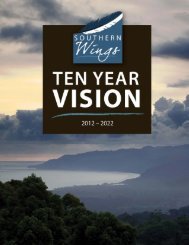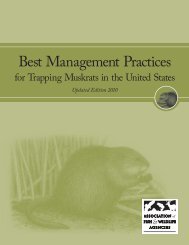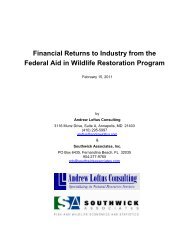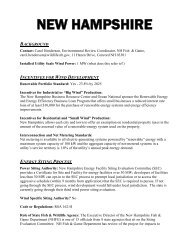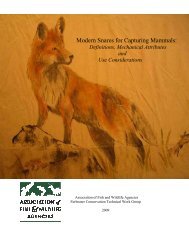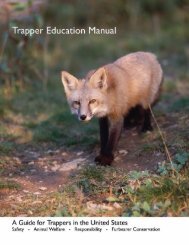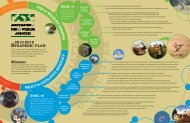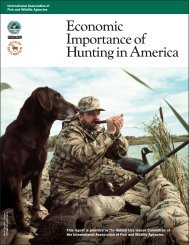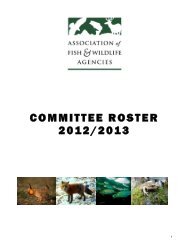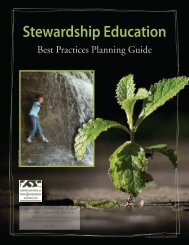Indiana - Association of Fish and Wildlife Agencies
Indiana - Association of Fish and Wildlife Agencies
Indiana - Association of Fish and Wildlife Agencies
You also want an ePaper? Increase the reach of your titles
YUMPU automatically turns print PDFs into web optimized ePapers that Google loves.
PARTNERS IN FLIGHT CONTINENTAL PRIORITIES AND OBJECTIVESDEFINED AT THE STATE ANDBIRD CONSERVATION REGION LEVELSINDIANAKenneth V. RosenbergPIF Northeast Regional CoordinatorCornell Lab <strong>of</strong> Ornithology159 Sapsucker Woods Rd.Ithaca, NY 14850607-254-2412kvr2@cornell.eduCornell Lab <strong>of</strong> OrnithologyMay 2004PIF Priorities <strong>and</strong> Objectives Defined at the State <strong>and</strong> BCR Level: <strong>Indiana</strong> 1May 2004
Part I: User’s GuideIntroduction <strong>and</strong> BackgroundRecognition that a cooperative, nonadversarial conservation approach was required to address bird<strong>and</strong> habitat issues led to formation in 1990 <strong>of</strong> Partners in Flight (PIF). The PIF mission is expressedthrough three related concepts:Helping species at risk. Species exhibiting warning signs today must be conserved before theybecome imperiled. Allowing species to become threatened or endangered results in long-term <strong>and</strong>costly recovery efforts whose success <strong>of</strong>ten is not guaranteed.Keeping common birds common. Native birds, both resident <strong>and</strong> migratory, must be retained inhealthy numbers throughout their natural ranges.Voluntary partnerships for birds, habitat, <strong>and</strong> people. A central premise <strong>of</strong> PIF is that theresources <strong>of</strong> public <strong>and</strong> private organizations throughout the Americas must be combined,coordinated, <strong>and</strong> increased in order to achieve success in conserving bird populations in thishemisphere.Over the last seven years, PIF has engaged in a comprehensive planning effort, resulting in severaldozen regional bird conservation plans covering all states or physiographic areas in the U.S. (Pashleyet al. 2000). Similar regional efforts are underway in Canada <strong>and</strong> Mexico. These regional <strong>and</strong> statePIF plans (see www.partnersinflight.org) identify priority species <strong>and</strong> habitats, set goals <strong>and</strong>objectives, discuss local issues <strong>and</strong> opportunities, <strong>and</strong> outline strategies for local or regional partnersto implement bird conservation objectives. In 2004, PIF published its North American L<strong>and</strong>birdConservation Plan (Rich et al. 2004), which synthesized l<strong>and</strong>bird priorities <strong>and</strong> objectives at acontinental scale <strong>and</strong> set forth a coordinated approach to l<strong>and</strong>bird conservation among nations <strong>and</strong>regions <strong>of</strong> North America. The North American L<strong>and</strong>bird Conservation Plan is a blueprint forcontinental l<strong>and</strong>bird conservation <strong>and</strong>, as such, is not intended to replace existing or developingregional <strong>and</strong> state PIF plans. The conservation <strong>and</strong> management strategies required for severalhundred l<strong>and</strong>bird species are far too complex <strong>and</strong> variable across North America to be treated only ata continental scale. Implementation <strong>of</strong> on-the-ground bird conservation strategies must take place atstate, provincial, <strong>and</strong> local levels, guided by regional <strong>and</strong> continental planning.Throughout the development <strong>of</strong> regional <strong>and</strong> continental bird conservation plans, PIF has followed astepwise planning approach, based on the best available scientific data <strong>and</strong> judgments from a broadspectrum <strong>of</strong> bird conservation experts. Originally described as the PIF "Flight Plan" (Pashley et al.2000), these steps include• assessing conservation vulnerability among all native l<strong>and</strong>bird species,• identifying species most in need <strong>of</strong> conservation attention at continental <strong>and</strong> regional levels,• setting quantitative population objectives for species <strong>of</strong> conservation importance,• identifying conservation needs <strong>and</strong> recommended actions for priority species <strong>and</strong> theirhabitats,• outlining an implementation strategy for meeting species <strong>and</strong> habitat objectives, <strong>and</strong>• evaluating success, making revisions, <strong>and</strong> setting updated objectives for the future.An unprecedented opportunity to implement bird <strong>and</strong> habitat objectives identified by PIF <strong>and</strong> theother bird-conservation initiatives exists with the State <strong>Wildlife</strong> Grants program. In order to make thePIF Priorities <strong>and</strong> Objectives Defined at the State <strong>and</strong> BCR Level: <strong>Indiana</strong> 2May 2004
est use <strong>of</strong> the State <strong>Wildlife</strong> Grants program, Congress charged each state <strong>and</strong> territory withdeveloping a statewide Comprehensive <strong>Wildlife</strong> Conservation Strategy (Strategies). These Strategieswill provide an essential foundation for the future <strong>of</strong> wildlife conservation <strong>and</strong> a stimulus to engagethe states, federal agencies, <strong>and</strong> other conservation partners to strategically think about theirindividual <strong>and</strong> coordinate roles in prioritizing conservation efforts across the nation. In developing theStrategies, the needs <strong>of</strong> bird species <strong>and</strong> their habitats will be considered along with needs for allother taxa.Our intent in this report is to summarize the detailed information from PIF bird conservation plansthat is most relevant to state planners <strong>and</strong> biologists as they develop the Strategies. The report isbroken into two parts—Part I is a user’s guide that explains the st<strong>and</strong>ardized set <strong>of</strong> procedures <strong>and</strong>assumptions used to develop the data <strong>and</strong> information for each state. The data <strong>and</strong> information ispresented in Part II. This information includes• priority species for each state, based on the PIF continental <strong>and</strong> physiographic area planningprocess;• population estimates for each state, broken into portions <strong>of</strong> Bird Conservation Regions(BCRs) within each state;• population objectives <strong>and</strong> numerical targets for each priority species, based on methodsdefined in the PIF North American L<strong>and</strong>bird Conservation Plan; <strong>and</strong>• a cross referenced list <strong>of</strong> where relevant conservation issues, management recommendations,research <strong>and</strong> monitoring needs are found in the physiographic area <strong>and</strong> state PIF plans.The priority species in each state, along with their state <strong>and</strong> BCR population estimates <strong>and</strong> targets, arepresented separately for each major habitat type within each state. These suites <strong>of</strong> species are similarto the habitat-species suites presented in many physiographic area <strong>and</strong> state PIF plans <strong>and</strong> representgroups <strong>of</strong> focal species that will benefit most from conservation actions within a given habitat type.The priority species are listed within the species-habitat suite that is their primary breeding habitat.The first table within each habitat-species suite contains the priority species that breed primarily inthat habitat, a population estimate within the portion <strong>of</strong> each BCR found within the states for eachspecies, the continental population objectives from the PIF North American L<strong>and</strong>bird ConservationPlan for each species, <strong>and</strong> the state numerical population target for each species that is needed to meetthe continental objectives. The first table also contains two columns indicating the species priority tierscores for breeding (B_Tier) <strong>and</strong> non breeding or wintering (N_Tier) species. The second table withineach habitat-species suite presents the numerical statewide population objectives for the priorityspecies using the information from the first table. The last section within each habitat-species suite isa cross referenced list <strong>of</strong> where information on goals, objectives, strategies <strong>and</strong> individual speciesaccounts are located in the relevant PIF physiographic area <strong>and</strong> state plans.The information described above is provided for every state, following a st<strong>and</strong>ardized set <strong>of</strong>procedures <strong>and</strong> assumptions (detailed in Part I <strong>of</strong> this report), recognizing that states will vary in theirapproach to developing the strategies <strong>and</strong> in their need for specific types <strong>of</strong> information from PIFplans. The methods described below are adapted from several key sources, which should be consultedfor greater detail if needed. These sources include: Carter et al. (2000), for (now slightly out-<strong>of</strong>-date)descriptions <strong>of</strong> the PIF species prioritization process; Pashley et al. (2000), for a summary <strong>of</strong> the PIFphysiographic area plans; Panjabi et al. (2001), for a h<strong>and</strong>book to using the PIF species assessmentdatabase; the Rocky Mountain Bird Observatory web site (www.rmbo.org/pif/pifdb.html), forviewing PIF species assessment scores <strong>and</strong> accompanying data; Rosenberg <strong>and</strong> Wells (in press) for anexample <strong>of</strong> a regional PIF synthesis; <strong>and</strong> Rosenberg <strong>and</strong> Blancher (in press), for a description <strong>of</strong> howPIF sets population objectives. These references are currently, or will soon be, available on the PIFPIF Priorities <strong>and</strong> Objectives Defined at the State <strong>and</strong> BCR Level: <strong>Indiana</strong> 3May 2004
web site: www.partnersinflight.org. In addition, the following sections <strong>of</strong> the North AmericanL<strong>and</strong>bird Conservation Plan (Rich et al. 2004) are most relevant to underst<strong>and</strong>ing the process fordeveloping state <strong>and</strong> local population estimates <strong>and</strong> objectives: Table 1, Species <strong>of</strong> continentalimportance for the U.S. <strong>and</strong> Canada; Appendix A, Assessment scores <strong>and</strong> estimated population size<strong>of</strong> North American l<strong>and</strong>birds; <strong>and</strong> Appendix B, Methods used to estimate population sizes <strong>and</strong>percents. Finally, the author is available for questions <strong>and</strong> consultation at kvr2@cornell.edu or (607)254-2412.PIF priority speciesBird species may be <strong>of</strong> conservation importance in a state for several reasons, including rarity or highthreats to populations within the state, representation in rare or unique habitats within the state, orbecause <strong>of</strong> larger regional or even global concerns for the species. PIF bird conservation plansprovide lists <strong>of</strong> species considered priorities for conservation action at continental, physiographicarea, or (in some cases) state levels. Providing PIF priority species lists to all states provides plannerswith an assessment <strong>of</strong> which species may require coordinated regional (i.e. inter-state) actions, as wellas for which species their state can make the most significant regional or national conservationcontribution. In Part II <strong>of</strong> this report, we provide PIF priority lists for each state, partitioned accordingto the status <strong>of</strong> each species in portions <strong>of</strong> BCRs overlapping each state.The first step in PIF’s planning process is to identify species most in need <strong>of</strong> attention, based on aconservation status assessment <strong>of</strong> each species throughout its range <strong>and</strong> annual cycle. PIF hasdeveloped a process that evaluates several components <strong>of</strong> species vulnerability <strong>and</strong> provides anoverall conservation assessment <strong>of</strong> the species (Hunter et al. 1993, Carter et al. 2000, Panjabi et al.2001). This process has been tested, reviewed, <strong>and</strong> updated, <strong>and</strong> its scientific credibilityacknowledged by the American Ornithologists’ Union (Beissinger et al. 2000).Species assessment is based on the PIF North American Species Assessment Database, whichcontains st<strong>and</strong>ardized data on the status <strong>of</strong> North American l<strong>and</strong>birds at the continental scale(www.rmbo.org/pif/pifdb.html). During the development <strong>of</strong> the North American L<strong>and</strong>birdConservation Plan, the PIF Science Committee reviewed the data <strong>and</strong> consulted other appropriateexperts on all factors in the database to ensure that our assessment reflects the current state <strong>of</strong>knowledge.Each species was assigned "global" scores for six factors that assess distinct aspects <strong>of</strong> vulnerabilityacross the species' entire range: Population Size (PS), Breeding Distribution (BD), NonbreedingDistribution (ND), Threats to Breeding (TB), Threats to Nonbreeding (TN), <strong>and</strong> Population Trend(PT). Scores for each factor reflect the degree <strong>of</strong> each species’ vulnerability (i.e., risk <strong>of</strong> significantpopulation decline or rangewide extinction) as a result <strong>of</strong> that factor. Scores ranged from “1” for lowvulnerability to “5” for high vulnerability. Complete descriptions, justifications, scoring criteria, <strong>and</strong>definitions for each factor can be found in Panjabi et al. (2001), available at the Rocky Mountain BirdObservatory web site (www.rmbo.org/pif/pifdb.html).To determine species <strong>of</strong> conservation importance at the continental scale, we calculated a CombinedScore, which is a single metric <strong>of</strong> a species’ relative conservation importance. The Combined Score iscalculated as (highest <strong>of</strong> TB or TN scores) + (highest <strong>of</strong> BD or ND scores) + PT + PS. This score canrange from 4 for a widespread, relatively secure species for which we have few concerns, to 20 for aspecies <strong>of</strong> the very highest concern. The most vulnerable species are those with a combination <strong>of</strong>small <strong>and</strong> declining populations, limited distributions, <strong>and</strong> deteriorating habitats. Species were placedon PIF's Continental Watch List if they had a Combined Score ≥ 14, or a Combined Score = 13 withPopulation Trend score = 5 (the latter representing a 50% decline over 30 years).PIF Priorities <strong>and</strong> Objectives Defined at the State <strong>and</strong> BCR Level: <strong>Indiana</strong> 4May 2004
In addition to species on the Continental Watch List, we identified species <strong>of</strong> regional importance ineach BCR, following methods used in many PIF physiographic area plans (e.g. Rosenberg <strong>and</strong> Wells,in press, www.partnersinflight.org). Species <strong>of</strong> regional importance were identified based on four“global” factors (PS, BD, ND, TN), as well as threats to breeding populations (TB), population trend(PT), <strong>and</strong> area importance (AI) scores, which are specific to each BCR. Area Importance is scoredaccording to the relative abundance <strong>of</strong> a species in a BCR (based on BBS abundance or equivalent),relative to the maximum abundance that species achieves across all BCRs. Categories <strong>of</strong> prioritystatus are determined by examining combinations <strong>of</strong> factor scores, as well as the total rank score,which is a measure <strong>of</strong> overall conservation priority. For more information about how scores areassigned see the PIF H<strong>and</strong>book <strong>of</strong> Species Prioritization athttp://www.rmbo.org/pubs/downoads/H<strong>and</strong>book.pdf.Species <strong>of</strong> conservation importance identified for each state, therefore, represent a combination <strong>of</strong>species on the PIF Continental Watch List, <strong>and</strong> additional species that meet criteria for regionalimportance in BCRs that overlap each state. The resulting "priority tiers" listed for each state aredefined specifically as follow:Tier I. High Continental Importance. -- Species on the PIF Continental Watch List, which aretypically <strong>of</strong> conservation concern throughout their range. These are species showing highvulnerability in a number <strong>of</strong> factors, expressed as any combination <strong>of</strong> high global parameterscores, with AI ≥ 2 (so that species without manageable populations in the region are omitted).High level conservation attention warranted.Tier II. High Regional Priority. Species that are <strong>of</strong> moderate continental priority (not onContinental Watch List), but are important to consider for conservation within a region because<strong>of</strong> various combinations <strong>of</strong> high parameter scores, as defined below; total <strong>of</strong> 7 parameter scores= ≥ 19.Tier IIA. High Regional Concern. Species that are experiencing declines in the core <strong>of</strong> theirrange <strong>and</strong> that require conservation action to reverse or stabilize trends. These are species with acombination <strong>of</strong> high area importance <strong>and</strong> declining (or unknown) population trend; total <strong>of</strong> 7parameters ≥ 19, with AI + PT ≥ 8.Tier IIB. High Regional Responsibility. Species for which this region shares in theresponsibility for long-term conservation, even if they are not currently declining or threatened.These are species <strong>of</strong> moderate overall priority with a disproportionately high percentage <strong>of</strong> theirtotal population in the region; total <strong>of</strong> 7 parameters ≥ 19, with AI = 5 or % population >threshold (see http://www.rmbo.org/pubs/downoads/H<strong>and</strong>book.pdf).Tier IIC. High Regional Threats. Species <strong>of</strong> moderate overall priority that are uncommon in aregion <strong>and</strong> whose remaining populations are threatened, usually because <strong>of</strong> extreme threats tosensitive habitats. These are species with high breeding threats scores within the region (or incombination with high nonbreeding threats outside the region); total <strong>of</strong> 7 parameters ≥ 19 withTB + TN > 6, or local TB or TN = 5.Scores for all breeding <strong>and</strong> wintering species in each BCR, as well as priority tiers assigned to eachspecies, may be found at: http://www.rmbo.org/pif/pifdb.html.Population estimatesPIF Priorities <strong>and</strong> Objectives Defined at the State <strong>and</strong> BCR Level: <strong>Indiana</strong> 5May 2004
As part <strong>of</strong> the development <strong>of</strong> the North American L<strong>and</strong>bird Conservation Plan (Rich et al 2004), PIFestimated the “current global” population size for each <strong>of</strong> 448 l<strong>and</strong>bird species. These estimates givean impression <strong>of</strong> the size <strong>of</strong> the l<strong>and</strong>bird resource, <strong>and</strong> more importantly they emphasize themagnitude <strong>of</strong> the task <strong>of</strong> attaining l<strong>and</strong>bird population objectives. Continental (U.S. <strong>and</strong> Canada)population estimates provide a starting point for estimating population sizes in states, provinces orBCRs, <strong>and</strong> an underst<strong>and</strong>ing <strong>of</strong> the magnitude <strong>of</strong> attaining objectives regionally. In Part II <strong>of</strong> thisreport we provide population estimates for all continental <strong>and</strong> regionally important bird speciespresented by habitat-species suite in each state, listed by the portions <strong>of</strong> BCRs within that state.The following methodology is excerpted from Rich et al (2004); Appendix B, which providesadditional details. We used Breeding Bird Survey (BBS) data from the 1990s as the basis forpopulation estimates across the U.S. <strong>and</strong> across Canada south <strong>of</strong> the arctic (i.e., excluding BCR 3, seenext section). BBS-based estimates <strong>of</strong> abundance were calculated according to the following steps:1) For each BBS route run within acceptable weather conditions, counts were averaged acrossyears to give a single average count for the 1990s for each species recorded on each route.2) Species counts were averaged across all BBS routes in each geo-political polygon defined bythe intersection <strong>of</strong> a BCR <strong>and</strong> a state.3) Indices <strong>of</strong> abundance were calculated for each geo-political polygon by multiplying averagecounts per BBS route times area <strong>of</strong> the geo-political polygon, <strong>and</strong> dividing by the theoreticalarea covered by a BBS route (25.1 km 2 , assuming 400-m radius around each <strong>of</strong> the 50 countcircles). For example, the index <strong>of</strong> abundance for Wood Thrushes in the BCR 28 portion <strong>of</strong>New York equals 10.71 birds/route (29 routes sampled in 1990s) x 37,872 km 2 (area <strong>of</strong> NewYork) / 25.1 km 2 (area per BBS route) equals approximately 16,000.4) State-wide indices <strong>of</strong> abundance were calculated by simple addition across all polygonsmaking up each state, thus giving a population index for Wood Thrushes in all <strong>of</strong> New York<strong>of</strong> approximately 52,000. BCR-wide indices <strong>of</strong> abundance were calculated in the samemanner.5) State-wide indices <strong>of</strong> abundance were converted to population estimates by applying threecorrection factors (see Rosenberg <strong>and</strong> Blancher, in press, for more detail on these correctionfactors):Pair correction: Indices were multiplied by two on the assumption that typically a singlemember <strong>of</strong> a breeding pair is observed during BBS tallies;Detection area correction: Each species was placed into one <strong>of</strong> five detection distancecategories, based on presumed effective detection during 3-minute BBS counts: 80m, 125m,200m, 400m <strong>and</strong> 800m. Because area <strong>of</strong> detection increases as the square <strong>of</strong> detectiondistance, the detection area correction is then simply the square <strong>of</strong> the ratio between 400m(theoretical BBS count circle) <strong>and</strong> species-specific effective distance. For example for WoodThrush, placed in the 200m class, the population index is multiplied by a detection areacorrection <strong>of</strong> 4 (square <strong>of</strong> 400/200). Note that effective detection distances are intended toincorporate not only the distance at which a species is normally heard <strong>and</strong> seen, but also thedistance the species moves during a 3-min count period – this is why some wide-rangingspecies have been assigned an 800-m detection distance despite being counted within a 400-m BBS circle.PIF Priorities <strong>and</strong> Objectives Defined at the State <strong>and</strong> BCR Level: <strong>Indiana</strong> 6May 2004
Time <strong>of</strong> day correction: Almost all species show a temporal change in detection across the50 BBS stops, some declining from a dawn chorus, others peaking after sunrise or later in themorning. A time <strong>of</strong> day correction is applied to the population index to adjust counts to themaximum time <strong>of</strong> detection. This adjusts for birds not detected at other times <strong>of</strong> the morning.The correction factor is the ratio <strong>of</strong> counts at the peak <strong>of</strong> detection (calculated using apolynomial curve fit to smooth out stop-by-stop variance) relative to the average count overwhole BBS routes. Time <strong>of</strong> day correction factors were calculated from survey-wide BBSstop-by-stop data. For Wood Thrush, whose detectability declines from a peak at BBS stop1, the time <strong>of</strong> day correction is 2.30.For Wood Thrushes, the population estimate for New York = 52,000 (index from step 4) x 2 (paircorrection) x 4 (detection area correction) x 2.30 (time <strong>of</strong> day correction) = roughly 960,000 breedingindividuals.For a variety <strong>of</strong> reasons, the population estimates presented in Part II are rough estimates <strong>and</strong> willneed to be improved over time, especially for use at smaller scales. Two main assumptions <strong>of</strong> theapproach are mentioned here (see Rosenberg <strong>and</strong> Blancher, in press).Assumption: Habitats are sampled in approximate proportion to their occurrence in the regionall<strong>and</strong>scape. Although BBS is designed to provide a r<strong>and</strong>om sample <strong>of</strong> the l<strong>and</strong>scape, limitations <strong>of</strong> aroad-based survey mean that the l<strong>and</strong>scape sampled is a biased representation <strong>of</strong> available habitat –for example species characteristic <strong>of</strong> high elevation habitats are likely to be undersampled by BBSsimply because roads tend to follow valley bottoms in mountainous regions. In northern BCRs, thereis a geographic bias, with most BBS data available from the southern portions <strong>of</strong> those BCRs.Checklist <strong>and</strong> Breeding Bird Census sites are determined by individual scientists <strong>and</strong> volunteers, soare not a r<strong>and</strong>om sample <strong>of</strong> arctic regions. We have not accounted for habitat bias in our continentalestimates, in part because it will differ from region to region, <strong>and</strong> because the magnitude <strong>of</strong> bias hasnot yet been estimated in many regions or at a continental scale. Correction for habitat bias should beconsidered when using the methods described above at smaller scales.Assumption: Birds present but not detected during BBS counts are accounted for, on balance, by oneor more <strong>of</strong> the three density corrections applied above (pair, detection area, <strong>and</strong> time <strong>of</strong> daycorrections). Species that have a peak <strong>of</strong> detection outside <strong>of</strong> the BBS sampling window (e.g., earlyseasonbreeders, most nocturnal species) are likely to have been underestimated. Pair corrections mayresult in over-estimation <strong>of</strong> population size, if a high proportion <strong>of</strong> counts involve either bothmembers <strong>of</strong> a pair, or unmated birds.In addition to stating assumptions behind this population estimation procedure, PIF has assessed theaccuracy <strong>and</strong> precision <strong>of</strong> population estimates for each species. Overall, about two-thirds <strong>of</strong> the“global” population estimates presented in the North American L<strong>and</strong>bird Conservation Plan are ratedas having fair to moderate accuracy, expected to be within <strong>and</strong> usually well within an order <strong>of</strong>magnitude <strong>of</strong> the correct breeding population. Estimates are least accurate for wide-ranging specieswith large populations in northern Canada or south <strong>of</strong> the U.S.; for many <strong>of</strong> these species ourestimates for the U.S. population <strong>and</strong> that <strong>of</strong> many states, will be more accurate than our “global”estimate. For species estimates based largely on BBS abundance, we also assessed the precision <strong>of</strong>these estimates, a measure <strong>of</strong> how repeatable the estimate is given the variance among counts. Resultsshow that most estimates are repeatable within 10% or 20%; i.e., repeatability <strong>of</strong> the estimate isgenerally high or very high, even when accuracy was rated as fair to moderate (summarized in Rich etal, 2004; Appendix B).Population objectivesPIF Priorities <strong>and</strong> Objectives Defined at the State <strong>and</strong> BCR Level: <strong>Indiana</strong> 7May 2004
For each state, we list the population objective <strong>and</strong> numerical population targets for the continental<strong>and</strong> regionally important species by habitat-species suite, within the portions <strong>of</strong> BCRs that overlapthat state (See Part II). Population objectives are based on rangewide population trends <strong>of</strong> species, asdescribed below, <strong>and</strong> targets are based on population estimates described above.Setting population objectives requires knowledge <strong>of</strong> population size <strong>and</strong> trends, as well as agreementon historic baselines to which present-day populations can be compared. As a starting point, the targetfor PIF priority species is to maintain current populations, or to return declining populations at least totheir numbers in the late 1960s. This date was selected because we believe that target is achievable<strong>and</strong> realistic for most species <strong>of</strong> conservation importance. Acceptance <strong>of</strong> this baseline recognizes thatthe extensive losses <strong>and</strong> modifications <strong>of</strong> habitat since the European settlement <strong>of</strong> North America arehistorical realities that are not likely to be reversed to a significant extent at the continental level. Italso recognizes that prior to 1966 <strong>and</strong> the start <strong>of</strong> the Breeding Bird Survey, there were no consistentdata for most l<strong>and</strong>bird species upon which to base measurable population objectives.Population objectives were determined for each species based on degree <strong>of</strong> population change since1966, according to the trend data used in the species assessment process. However, we recognize thattrend estimates are not exact. Rather than proposing population objectives that represent estimates <strong>of</strong>the actual number <strong>of</strong> birds in 1966 (which would generate a different target for each species), weassigned each species to one <strong>of</strong> four population objective categories, as described below. For now,these objectives are based on trends at the continental level, <strong>and</strong> defined for each state to help meetcontinental targets. Refinement <strong>of</strong> this process <strong>and</strong> comparison with local <strong>and</strong> regional data <strong>and</strong>targets, may dictate more or less aggressive objectives than for the species continental targets. Forregionally important species not on the Continental Watch List, continental estimates <strong>of</strong> trends areused to determine objectives <strong>and</strong> targets, as with Watch List species described in Rich et al (2004).For species that are the subject <strong>of</strong> legally m<strong>and</strong>ated Recovery Plans, we defer to the objectives <strong>of</strong>those plans.Double Population: For all species that have undergone severe declines <strong>of</strong> 50% or more over 30 years(i.e., those with Population Trend scores <strong>of</strong> 5), the objective is to double the current population overthe next 30 years. Reversing declines <strong>and</strong> doubling present-day populations is warranted for nearly athird <strong>of</strong> the 100 species on PIF's Continental Watch List.Increase Population by 50%: For species that have undergone moderate declines (15-50% over 30years, as indicated by Population Trend scores <strong>of</strong> 4), the objective is to increase the population by50% over the next 30 years. This objective is warranted for 23 Continental Watch List Species.Maintain/Increase Population: Watch List Species with uncertain or unknown past trend (PopulationTrend scores <strong>of</strong> 3) may be seriously declining without our knowledge. Our conservative objective forthese species, therefore, is to maintain or increase current populations in the next 30 years whilesimultaneously improving our knowledge <strong>of</strong> population status. This is the objective for 33Continental Watch List Species.Maintain Population: For species with stable or increasing populations, PIF’s objective is to at leastmaintain current populations.By combining the suggested population objectives with our initial estimates <strong>of</strong> population size, a firstapproximation <strong>of</strong> a numerical population target for each species at the continental, regional <strong>and</strong> statelevels can be determined. These are listed separately for each species in each BCR polygon within astate. For example, the North American L<strong>and</strong>bird Conservation Plan calls for a doubling <strong>of</strong> present-PIF Priorities <strong>and</strong> Objectives Defined at the State <strong>and</strong> BCR Level: <strong>Indiana</strong> 8May 2004
day Brewer’s Sparrow populations over the next 30 years to restore a range-wide population <strong>of</strong>roughly 32 million breeding individuals. The portion <strong>of</strong> that target suggested for Idaho, thereforewould be to double the present-day population <strong>of</strong> 1.2 million Brewer's Sparrows, with 83% <strong>of</strong> thattarget being met in the BCR-9 portion <strong>of</strong> the state.Comparing <strong>and</strong> refining estimatesNumerous experts <strong>and</strong> many rounds <strong>of</strong> review have helped to make the process <strong>of</strong> estimatingpopulations as accurate as possible, <strong>and</strong> we hope that it will become a valuable tool in l<strong>and</strong>birdconservation. But we realize that these estimates provide a starting point, not a final answer.Significant discussions have already taken place <strong>and</strong> current efforts are underway to refine theprocess <strong>and</strong> assumptions <strong>of</strong> our methodology for calculating population estimates <strong>and</strong> assigningpopulation objectives. For example, our correction factors are being reviewed <strong>and</strong> revised byregional PIF groups, <strong>and</strong> additional correction factors are being proposed <strong>and</strong> developed (e.g., ahabitat bias correction factor). Regional <strong>and</strong> local population objectives are being proposed based ondata <strong>and</strong> knowledge at that scale to cumulatively support the continental population objective (seeAppendix A). Additionally, a Science Review Team not involved in the process <strong>of</strong> developing thismethodology has been created <strong>and</strong> will be meeting soon to provide an independent review <strong>of</strong> thepopulation estimation process with recommendations. Please consult with your state PIFrepresentative <strong>and</strong>/or your BCR or JV Coordinator to determine the status <strong>of</strong> these efforts <strong>and</strong> howthey may apply to the State <strong>Wildlife</strong> planning process. We look forward to the outcome <strong>of</strong> all theseefforts <strong>and</strong> anticipate substantial improvements with every North American L<strong>and</strong>bird ConservationPlan update as data, analysis <strong>and</strong> concepts improve.Therefore, it is important for users <strong>of</strong> these estimates to underst<strong>and</strong> the following:• All species assessment scores have a degree <strong>of</strong> uncertainty in the underlying information <strong>and</strong>pr<strong>of</strong>essional judgments were made in setting each score. See Carter et al. 2000 <strong>and</strong> Panjabi et al.2001 for details.• The “global” population size estimates rely on several assumptions <strong>and</strong> have a level <strong>of</strong> error thatcan only be approximated. Estimates will be revised as data improve <strong>and</strong> as the estimationprocess is refined. Revised estimates will be posted annually on the PIF web site(www.partnersinflight.com).• Rule sets were used to select Species <strong>of</strong> Continental Importance <strong>and</strong> to assign those species tocategories for Conservation Action <strong>and</strong> Monitoring Need. Different rule sets would producedifferent lists, but the ones used here are the result <strong>of</strong> exhaustive discussion <strong>and</strong> analysis byl<strong>and</strong>bird experts.• Population objectives are based on past population trend <strong>and</strong> are independent <strong>of</strong> population sizeestimates. Changes in population size estimates will have no effect on objectives, but improvedtrend information could have large effects. Objectives will be revised as appropriate.At the Population Objectives workshop in Texas (February, 2004), <strong>and</strong> at several regional workshops,the process <strong>of</strong> comparing our "top-down" BBS-derived population estimates (see Part II) with locallyderived "bottom-up" estimates was begun. We urge that additional comparisons be made whereverlocal data for priority bird species exist. These comparisons have produced "mixed" results to date,with some species well within expected ranges <strong>and</strong> other estimates based on different approaches notyet very close.Disparity or similarity between estimates derived from the process described in this report vs. abottom-up (local/regional) approach does not necessarily mean that one or both estimates are wrong.PIF Priorities <strong>and</strong> Objectives Defined at the State <strong>and</strong> BCR Level: <strong>Indiana</strong> 9May 2004
In all cases, the assumptions <strong>of</strong> each approach need to be carefully evaluated. Initial comparisonshave suggested that one or more correction factors for some species may need revision, resulting incomparisons that are much closer. In some cases, re-thinking <strong>of</strong> local density information with respectto what constitutes suitable habitat has also resulted in closer comparisons. Ultimately, populationestimates based on accurate habitat-suitability <strong>and</strong> -availability models will be needed to evaluate theaccuracy <strong>and</strong> utility <strong>of</strong> the process described in this report.Issues <strong>and</strong> recommendations by habitat-species suitesFor each habitat-species suite, we provide a cross referenced list where information on conservationissues, management recommendations, research <strong>and</strong> monitoring needs, <strong>and</strong> individual speciesaccounts most relevant to that habitat or group <strong>of</strong> species are located. The list will direct the reader tospecific pages within the relevant sections <strong>of</strong> PIF physiographic area <strong>and</strong> state plans. Our aim issimply to provide a link to information from the bird conservation plans. We therefore have not addednew information or filled in gaps where information for a particular species or habitat is lacking atpresent.Next Step: Deriving habitat objectivesIn most (but not all) cases, conservation actions aimed at maintaining or restoring healthy populations<strong>of</strong> l<strong>and</strong>birds will be directed at habitat. It is desirable, therefore, to set explicit habitat objectives <strong>and</strong>targets for species or suites <strong>of</strong> priority bird species. Deriving quantitative habitat objectives for birdsrequires an additional set <strong>of</strong> assumptions (for example, that habitat is limiting for a given species),knowledge <strong>of</strong> local or habitat-specific densities, knowledge <strong>of</strong> habitat-related limiting factors, <strong>and</strong><strong>of</strong>ten a complex GIS-based modeling approach. Such analyses are beyond the scope <strong>of</strong> this report. Ast<strong>and</strong>ardized five-step approach to modeling habitat requirements for meeting PIF l<strong>and</strong>bird objectiveswas discussed at the recent Population Objectives Workshop in Port Aransas, TX (February, 2004).After further discussions a detailed description <strong>of</strong> the five-step, long term process will bedisseminated.A simple, first-cut estimate <strong>of</strong> habitat requirements for bird populations can be attempted, however,using population estimates <strong>and</strong> habitat-specific density information. These estimates may be derivedusing the equation: Habitat Area = Population Estimate X Density (birds/unit area). These habitatobjectives have been used in some PIF physiographic area plans (primarily in Northeast Region), buttheir acceptance is far from widespread. Nevertheless, these numerical estimates have provenextremely valuable for conveying region-wide habitat conservation needs, such as in the <strong>Wildlife</strong>Management Institute's Farm Bill report, How Much is Enough? (WMI 2001). For example, weestimated that roughly 4.5 million acres <strong>of</strong> suitable grassl<strong>and</strong> habitat are required across the NortheastU.S. to support 1.6 million pairs <strong>of</strong> nesting Bobolinks -- these numbers were translated into specificgoals for Farm Bill programs.These simple habitat estimates may be most reasonable for birds with simple habitat requirements,such as grassl<strong>and</strong> species. For many forest birds, however, local density-derived habitat estimates arenot considered reasonable, because species are patchily distributed within a matrix <strong>of</strong> potentiallysuitable habitat. For these birds, defining "suitable" habitat is critical, <strong>and</strong> more complex habitatmodelingtechniques are required.ReferencesCarter, M. F., W. C. Hunter, D. N. Pashley, <strong>and</strong> K. V. Rosenberg. 2000. Setting conservationpriorities for l<strong>and</strong>birds in the United States: The Partners in Flight Approach. Auk 117:541–548.PIF Priorities <strong>and</strong> Objectives Defined at the State <strong>and</strong> BCR Level: <strong>Indiana</strong> 10May 2004
Beissinger, S.R., J.M. Reed, J.M. Wunderle, Jr., S.K Robinson, <strong>and</strong> D.M. Finch. 2000. Report <strong>of</strong> theAOU Conservation Committee on the Partners in Flight species prioritization plan. The Auk.117(2): 549-561.Hunter, W. C., M.F. Carter, D.N. Pashley, <strong>and</strong> K. Barker. 1993. The Partners in Flight prioritizationscheme. Pages 109-119 in Status <strong>and</strong> Management <strong>of</strong> Neotropical Migratory Birds (D. Finch <strong>and</strong> P.Stangel, Eds.). USDA Forest Service General Technical Report RM-229.USDA Forest Service,Fort Collins, Colorado.Panjabi, A., C. Beardmore, P. Blancher, G. Butcher, M. Carter, D. Demarest, E. Dunn, C. Hunter, D.Pashley, K. Rosenberg, T. Rich, <strong>and</strong> T. Will. 2001. The Partners in Flight H<strong>and</strong>book on SpeciesAssessment <strong>and</strong> Prioritization. Version 1.1. Rocky Mountain Bird Observatory, Brighton,Colorado.Pashley, D. N., C. J. Beardmore, J. A. Fitzgerald, R. P. Ford, W. C. Hunter, M. S. Morrison, <strong>and</strong> K.V. Rosenberg. 2000. Partners in Flight: Conservation <strong>of</strong> the L<strong>and</strong> Birds <strong>of</strong> the United States.American Bird Conservancy. The Plains, Virginia.Rich, T.D., C.J. Beardmore, H. Berlanga, P.J. Blancher, M.S.W. Bradstreet, G.S. Butcher, D.W.Demarest, E.H. Dunn, W.C. Hunter, E.E. Inigo-Elias, J.A. Kennedy, A.M. Martell, A.O. Panjabi,D.N. Pashley, K.V. Rosenberg, C.M. Rustay, J.S. Wendt, T.C. Will. 2004. Partners in Flight NorthAmerican L<strong>and</strong>bird Conservation Plan. Cornell Lab <strong>of</strong> Ornithology. Ithaca, NY.Rosenberg, K. V., <strong>and</strong> P. J. Blancher. In press. Setting numerical population objectives for priorityl<strong>and</strong>bird species. Pages xx–xx in Proceedings <strong>of</strong> the Third International Partners in FlightConference (C. J. Ralph <strong>and</strong> T. D. Rich, Eds.). USDA Forest Service General Technical ReportPSW-GTR-191. Albany, California.Rosenberg, K. V., <strong>and</strong> J.V. Wells. In press. Conservation priorities for terrestrial birds in thenortheastern United States. Pages xx–xx in Proceedings <strong>of</strong> the Third International Partners in FlightConference (C. J. Ralph <strong>and</strong> T. D. Rich, Eds.). USDA Forest Service General Technical ReportPSW-GTR-191. Albany, California.PIF Priorities <strong>and</strong> Objectives Defined at the State <strong>and</strong> BCR Level: <strong>Indiana</strong> 11May 2004
Part II: INDIANAThis report is Part II <strong>of</strong> a two-part report. Part I is a user’s guide that explains thest<strong>and</strong>ardized set <strong>of</strong> procedures <strong>and</strong> assumptions used to develop the data <strong>and</strong> information foreach state. Part II presents the PIF priority species data <strong>and</strong> information by habitat-speciessuites. The priority species are listed within the species-habitat suite that is their primarybreeding habitat. Please see Part I for a detailed explanation <strong>of</strong> the st<strong>and</strong>ardized process usedto develop Part II <strong>of</strong> this report.<strong>Indiana</strong> includes parts <strong>of</strong> three Partners in Flight physiographic areas:Interior Low Plateaus (14)Upper Great Lakes Plain (16)Prairie Peninsula (31)The individual Physiographic Area conservation plans address conservation issues <strong>and</strong>opportunities at the planning unit <strong>and</strong> habitat level. Planning unit cross-references are listedhere. Habitat cross-references are listed in each habitat section below.Physiographic Area 14 (Ford et al. 2000) . . . . . . . . . . . . . . . . . . . . . . . . . . . . . . . . . . . . page 2Physiographic Area 16 (Knutson et al. 2001) . . . . . . . . . . . . . . . . . . . . . . . . . . . . . . . . . . . . .11Physiographic Area 31 (Fitzgerald et al. 2000) . . . . . . . . . . . . . . . . . . . . . . . . . . . . . . . . . . . . 4FORESTPriority bird species that breed primarily in forests. Various forest types (deciduous, mixed,forested wetl<strong>and</strong>s, coniferous, riparian, savanna-woodl<strong>and</strong>s, etc.) are combined here for thepurposes <strong>of</strong> this report.Species BCREstimated Continental TargetB_Tier N_Tier Population Objective PopulationBlack-billed Cuckoo 22 II.a. 1,400 1.5 2,100Black-billed Cuckoo 23 II.a. 610 1.5 920Black-billed Cuckoo 24 1,300 1.5 2,000Yellow-billed Cuckoo 22 II.a. 13,000 1.5 20,000Yellow-billed Cuckoo 23 4,300 1.5 6,500Yellow-billed Cuckoo 24 II.a. 80,000 1.5 120,000Eastern Screech-Owl 22 3,700 1.0 3,700Eastern Screech-Owl 24 II.a. 3,000 1.0 3,000Long-eared Owl 23 II.a. ? 1.5 ?Long-eared Owl 24 II.a. ? 1.5 ?Chuck-will's-widow 22 II.c. ? 1.5 ?Chuck-will's-widow 24 30,000 1.5 45,000Whip-poor-will 22 II.a. 4,100 1.5 6,200Whip-poor-will 24 II.a. 29,000 1.5 44,000PIF Priorities <strong>and</strong> Objectives Defined at the State <strong>and</strong> BCR Level: <strong>Indiana</strong> 12May 2004
Species BCREstimated Continental TargetB_Tier N_Tier Population Objective PopulationRed-headed Woodpecker 22 I. I. 35,000 2.0 70,000Red-headed Woodpecker 23 I. I. 8,100 2.0 16,000Red-headed Woodpecker 24 I. I. 42,000 2.0 84,000Red-bellied Woodpecker 22 54,000 1.0 54,000Red-bellied Woodpecker 23 17,000 1.0 17,000Red-bellied Woodpecker 24 II.a. 170,000 1.0 170,000Northern Flicker 22 II.a. 46,000 1.5 69,000Northern Flicker 23 II.a. 19,000 1.5 29,000Northern Flicker 24 47,000 1.5 71,000Eastern Wood-Pewee 22 34,000 1.5 51,000Eastern Wood-Pewee 23 17,000 1.5 26,000Eastern Wood-Pewee 24 II.a. 100,000 1.5 150,000Acadian Flycatcher 22 II.a. 5,700 1.0 5,700Acadian Flycatcher 23 II.a. 7,400 1.0 7,400Acadian Flycatcher 24 II.a. 150,000 1.0 150,000Yellow-throated Vireo 22 5,300 1.0 5,300Yellow-throated Vireo 23 5,200 1.0 5,200Yellow-throated Vireo 24 II.a. 30,000 1.0 30,000Warbling Vireo 22 57,000 1.0 57,000Warbling Vireo 23 II.a. 24,000 1.0 24,000Warbling Vireo 24 74,000 1.0 74,000Carolina Chickadee 22 II.a. 49,000 1.5 74,000Carolina Chickadee 23 800 1.5 1,200Carolina Chickadee 24 II.a. 170,000 1.5 260,000Wood Thrush 22 I. 47,000 1.5 71,000Wood Thrush 23 I. 22,000 1.5 33,000Wood Thrush 24 I. 180,000 1.5 270,000Yellow-throated Warbler 22 3,800 1.0 3,800Yellow-throated Warbler 23 660 1.0 660Yellow-throated Warbler 24 II.b. 35,000 1.0 35,000Cerulean Warbler 22 I. 1,100 2.0 2,200Cerulean Warbler 23 I. 400 2.0 800Cerulean Warbler 24 I. 19,000 2.0 38,000Prothonotary Warbler 22 I. 170 1.5 260Prothonotary Warbler 23 270 1.5 410Prothonotary Warbler 24 I. 7,700 1.5 12,000Worm-eating Warbler 24 I. 13,000 1.0 13,000Ovenbird 22 II.c. 750 1.0 750Ovenbird 23 150 1.0 150Ovenbird 24 11,000 1.0 11,000Louisiana Waterthrush 22 II.a. 93 1.0 93Louisiana Waterthrush 24 II.a. 3,600 1.0 3,600Kentucky Warbler 22 I. 150 1.5 230PIF Priorities <strong>and</strong> Objectives Defined at the State <strong>and</strong> BCR Level: <strong>Indiana</strong> 13May 2004
Species BCREstimated Continental TargetB_Tier N_Tier Population Objective PopulationKentucky Warbler 24 I. 45,000 1.5 68,000Hooded Warbler 22 II.c. 180 1.0 180Hooded Warbler 23 180 1.0 180Hooded Warbler 24 13,000 1.0 13,000Canada Warbler 23 I. ? 1.5 ?Summer Tanager 22 710 1.0 710Summer Tanager 24 II.b. 21,000 1.0 21,000Scarlet Tanager 22 II.c. 2,900 1.0 2,900Scarlet Tanager 23 3,800 1.0 3,800Scarlet Tanager 24 45,000 1.0 45,000Rusty Blackbird 22 I. ? 2.0 ?Rusty Blackbird 23 I. ? 2.0 ?Rusty Blackbird 24 I. ? 2.0 ?Purple Finch 22 II.a. ? 1.5 ?Purple Finch 24 93 1.5 140State Population Objectives.SpeciesBlack-billed CuckooYellow-billed CuckooEastern Screech-OwlLong-eared OwlChuck-will’s-widowWhip-poor-willRed-headed WoodpeckerRed-bellied WoodpeckerNorthern FlickerEastern Wood-PeweeAcadian FlycatcherYellow-throated VireoWarbling VireoCarolina ChickadeeStatewide population objectives for forest speciesIncrease the statewide population from 3,300 individuals to5,000 individuals.Increase the statewide population from 97,000 individuals to150,000 individuals.Maintain the current statewide population <strong>of</strong> 6,700 individuals.Increase the statewide population. Population numbers areunavailable at this time.Increase the statewide population. Population numbers areunavailable at this time.Increase the statewide population from 33,000 individuals to50,000 individuals.Double the statewide population from 85,000 individuals to170,000 individuals.Maintain the current statewide population <strong>of</strong> 240,000 individuals.Increase the statewide population from 110,000 individuals to170,000 individuals.Increase the statewide population from 150,000 individuals to230,000 individuals.Maintain the current statewide population <strong>of</strong> 160,000 individuals.Maintain the current statewide population <strong>of</strong> 41,000 individuals.Maintain the current statewide population <strong>of</strong> 160,000 individuals.Increase the statewide population from 220,000 individuals to330,000 individuals.PIF Priorities <strong>and</strong> Objectives Defined at the State <strong>and</strong> BCR Level: <strong>Indiana</strong> 14May 2004
SpeciesWood ThrushYellow-throated WarblerCerulean WarblerProthonotary WarblerWorm-eating WarblerOvenbirdLouisiana WaterthrushKentucky WarblerHooded WarblerCanada WarblerSummer TanagerScarlet TanagerRusty BlackbirdPurple FinchStatewide population objectives for forest speciesIncrease the statewide population from 250,000 individuals to380,000 individuals.Maintain the current statewide population <strong>of</strong> 39,000 individuals.Double the statewide population from 21,000 individuals to42,000 individuals.Increase the statewide population from 8,100 individuals to12,000 individuals.Maintain the current statewide population <strong>of</strong> 13,000 individuals.Maintain the current statewide population <strong>of</strong> 12,000 individuals.Maintain the current statewide population <strong>of</strong> 3,700 individuals.Increase the statewide population from 45,000 individuals to68,000 individuals.Maintain the current statewide population <strong>of</strong> 13,000 individuals.Increase the statewide population. Population numbers areunavailable at this time.Maintain the current statewide population <strong>of</strong> 22,000 individuals.Maintain the current statewide population <strong>of</strong> 52,000 individuals.Double the statewide population. Population numbers areunavailable at this time.Increase the statewide population. Population numbers areunavailable at this time.Objectives, Strategies, Recommendations, <strong>and</strong> Research <strong>and</strong> Monitoring NeedsHabitat objectives, implementation strategies, management recommendations, <strong>and</strong> research<strong>and</strong> monitoring needs for forests are discussed in the following plans.Physiographic Area 14 (Ford et al. 2000)Western mesophytic, oak-hickory, <strong>and</strong> beech-maple forests . . . . . . . . . . . . . . . . . . . . . .page 9Western mesophytic, oak-hickory, beech-maple forests . . . . . . . . . . . . . . . . . . . . . . . . . . . . 45Forested wetl<strong>and</strong>s . . . . . . . . . . . . . . . . . . . . . . . . . . . . . . . . . . . . . . . . . . . . . . . . . . . . . . . . . . 19Forested wetl<strong>and</strong>s . . . . . . . . . . . . . . . . . . . . . . . . . . . . . . . . . . . . . . . . . . . . . . . . . . . . . . . . . . 45Riparian woodl<strong>and</strong>s . . . . . . . . . . . . . . . . . . . . . . . . . . . . . . . . . . . . . . . . . . . . . . . . . . . . . . . . 24Riparian woodl<strong>and</strong>s . . . . . . . . . . . . . . . . . . . . . . . . . . . . . . . . . . . . . . . . . . . . . . . . . . . . . . . . 46Physiographic Area 16 (Knutson et al. 2001)Savanna-woodl<strong>and</strong>s . . . . . . . . . . . . . . . . . . . . . . . . . . . . . . . . . . . . . . . . . . . . . . . . . . . . page 25Forests . . . . . . . . . . . . . . . . . . . . . . . . . . . . . . . . . . . . . . . . . . . . . . . . . . . . . . . . . . . . . . . . . . .32Broadleaved forest . . . . . . . . . . . . . . . . . . . . . . . . . . . . . . . . . . . . . . . . . . . . . . . . . . . . . . . . . 33Riparian forest . . . . . . . . . . . . . . . . . . . . . . . . . . . . . . . . . . . . . . . . . . . . . . . . . . . . . . . . . . . . .35Coniferous forest . . . . . . . . . . . . . . . . . . . . . . . . . . . . . . . . . . . . . . . . . . . . . . . . . . . . . . . . . . .36Swamp (forested) wetl<strong>and</strong>s . . . . . . . . . . . . . . . . . . . . . . . . . . . . . . . . . . . . . . . . . . . . . . . . . . .41PIF Priorities <strong>and</strong> Objectives Defined at the State <strong>and</strong> BCR Level: <strong>Indiana</strong> 15May 2004
Physiographic Area 31 (Fitzgerald et al. 2000)Savanna/woodl<strong>and</strong> . . . . . . . . . . . . . . . . . . . . . . . . . . . . . . . . . . . . . . . . . . . . . . . . . . . . . page 27Forests . . . . . . . . . . . . . . . . . . . . . . . . . . . . . . . . . . . . . . . . . . . . . . . . . . . . . . . . . . . . . . . . . . .32Individual Species AccountsSpecies accounts for forest priority species are included in the following plans.NoneAdditional forest species are included in the following plans.NoneSHRUB/EARLY SUCCESSIONALPriority bird species that breed primarily in shrub <strong>and</strong> early successional habitats. Variousshrubby habitats (natural shrub, power line right-<strong>of</strong>-ways, old fields, ab<strong>and</strong>oned pastures,reclaimed strip mines, etc.) are combined here for the purposes <strong>of</strong> this report.Species BCREstimated Continental TargetB_Tier N_Tier Population Objective PopulationNorthern Bobwhite 22 II.a. II.a. 51,000 2.0 100,000Northern Bobwhite 23 II.c. II.a. 16,000 2.0 32,000Northern Bobwhite 24 II.a. II.a. 97,000 2.0 190,000Willow Flycatcher 22 I. 27,000 1.5 41,000Willow Flycatcher 23 I. 16,000 1.5 24,000Willow Flycatcher 24 I. 9,700 1.5 15,000Eastern Kingbird 22 26,000 1.5 39,000Eastern Kingbird 23 15,000 1.5 23,000Eastern Kingbird 24 II.a. 57,000 1.5 86,000White-eyed Vireo 22 5,600 1.0 5,600White-eyed Vireo 23 1,700 1.0 1,700White-eyed Vireo 24 II.a. 110,000 1.0 110,000Bell's Vireo 22 I. 240 2.0 480Bell's Vireo 23 55 2.0 110Bell's Vireo 24 I. 1,600 2.0 3,200Bewick's Wren 24 II.c. ? 1.0 ?Brown Thrasher 22 II.a. II.a. 58,000 1.5 87,000Brown Thrasher 23 II.a. 11,000 1.5 17,000Brown Thrasher 24 II.a. 65,000 1.5 98,000Blue-winged Warbler 23 I. 880 1.5 1,300Blue-winged Warbler 24 I. 4,600 1.5 6,900Golden-winged Warbler 23 I. ? 2.0 ?Prairie Warbler 22 87 1.5 130PIF Priorities <strong>and</strong> Objectives Defined at the State <strong>and</strong> BCR Level: <strong>Indiana</strong> 16May 2004
Species BCREstimated Continental TargetB_Tier N_Tier Population Objective PopulationPrairie Warbler 24 I. 14,000 1.5 21,000Yellow-breasted Chat 22 12,000 1.0 12,000Yellow-breasted Chat 23 2,300 1.0 2,300Yellow-breasted Chat 24 II.a. 140,000 1.0 140,000Eastern Towhee 22 II.a. 18,000 1.5 27,000Eastern Towhee 23 5,600 1.5 8,400Eastern Towhee 24 II.a. 96,000 1.5 140,000American Tree Sparrow 23 II.a. ? 1.5 ?Field Sparrow 22 II.a. II.a. 110,000 2.0 220,000Field Sparrow 23 II.a. 59,000 2.0 120,000Field Sparrow 24 II.a. 150,000 2.0 300,000Orchard Oriole 22 II.a. 8,000 1.0 8,000Orchard Oriole 23 3,500 1.0 3,500Orchard Oriole 24 II.a. 42,000 1.0 42,000State Population Objectives.SpeciesNorthern BobwhiteWillow FlycatcherEastern KingbirdWhite-eyed VireoBell's VireoBewick’s WrenBrown ThrasherBlue-winged WarblerGolden-winged WarblerPrairie WarblerYellow-breasted ChatEastern TowheeAmerican Tree SparrowStatewide population objectives for shrub <strong>and</strong> earlysuccessional speciesDouble the statewide population from 160,000 individuals to320,000 individuals.Increase the statewide population from 53,000 individuals to80,000 individuals.Increase the statewide population from 98,000 individuals to150,000 individuals.Maintain the current statewide population <strong>of</strong> 120,000 individuals.Double the statewide population from 1,900 individuals to3,800 individuals.Maintain the current statewide population. Population numbersare unavailable at this time.Increase the statewide population from 130,000 individuals to200,000 individuals.Increase the statewide population from 5,500 individuals to8,300 individuals.Double the statewide population. Population numbers areunavailable at this time.Increase the statewide population from 14,000 individuals to21,000 individuals.Maintain the current statewide population <strong>of</strong> 150,000 individuals.Increase the statewide population from 120,000 individuals to180,000 individuals.Increase the statewide population. Population numbers arePIF Priorities <strong>and</strong> Objectives Defined at the State <strong>and</strong> BCR Level: <strong>Indiana</strong> 17May 2004
SpeciesField SparrowOrchard OrioleStatewide population objectives for shrub <strong>and</strong> earlysuccessional speciesunavailable at this time.Double the statewide population from 320,000 individuals to640,000 individuals.Maintain the current statewide population <strong>of</strong> 54,000 individuals.Objectives, Strategies, Recommendations, <strong>and</strong> Research <strong>and</strong> Monitoring NeedsHabitat objectives, implementation strategies, management recommendations, <strong>and</strong> research<strong>and</strong> monitoring needs for shrub <strong>and</strong> early successional habitats are discussed in the followingplans.Physiographic Area 14 (Ford et al. 2000) (Barrens, glades, <strong>and</strong> old fields) . . . . . . . . . page 34Physiographic Area 14 (Ford et al. 2000) (Barrens, glades, <strong>and</strong> old fields) . . . . . . . . . . . . . .46Physiographic Area 14 (Ford et al. 2000) (Short-rotation pine) . . . . . . . . . . . . . . . . . . . . . . .40Physiographic Area 14 (Ford et al. 2000) (Short-rotation pine) . . . . . . . . . . . . . . . . . . . . . . .46Physiographic Area 16 (Knutson et al. 2001) . . . . . . . . . . . . . . . . . . . . . . . . . . . . . . . . . . . . .28Individual Species AccountsSpecies accounts for shrub <strong>and</strong> early successional priority species are included in thefollowing plans.NoneAdditional shrub <strong>and</strong> early successional species are included in the following plans.NoneGRASSLAND/AGRICULTURALPriority bird species that breed primarily in grassl<strong>and</strong> <strong>and</strong> agricultural areas.Species BCREstimated Continental TargetB_Tier N_Tier Population Objective PopulationNorthern Harrier 22 330 1.5 500Northern Harrier 23 II.c. II.a. 19 1.5 29Northern Harrier 24 39 1.5 59Upl<strong>and</strong> S<strong>and</strong>piper 22 II.a. ? ? ?Upl<strong>and</strong> S<strong>and</strong>piper 23 II.a. ? ? ?Upl<strong>and</strong> S<strong>and</strong>piper 24 II.c. ? ? ?Short-eared Owl 22 I. ? 2.0 ?PIF Priorities <strong>and</strong> Objectives Defined at the State <strong>and</strong> BCR Level: <strong>Indiana</strong> 18May 2004
Species BCREstimated Continental TargetB_Tier N_Tier Population Objective PopulationShort-eared Owl 23 I. I. ? 2.0 ?Short-eared Owl 24 I. I. ? 2.0 ?Loggerhead Shrike 22 II.c. II.a. 70 2.0 140Loggerhead Shrike 24 II.c. 1,100 2.0 2,200Sedge Wren 22 II.c. 7,900 1.0 7,900Sedge Wren 23 II.a. 4,100 1.0 4,100Sedge Wren 24 II.c. 2,100 1.0 2,100Vesper Sparrow 22 180,000 1.5 270,000Vesper Sparrow 23 II.a. 61,000 1.5 92,000Vesper Sparrow 24 7,800 1.5 12,000Grasshopper Sparrow 22 II.a. 51,000 2.0 100,000Grasshopper Sparrow 23 II.a. 14,000 2.0 28,000Grasshopper Sparrow 24 II.a. 49,000 2.0 98,000Henslow's Sparrow 22 I. 230 2.0 460Henslow's Sparrow 23 I. 1,300 2.0 2,600Henslow's Sparrow 24 I. 7,200 2.0 14,000Dickcissel 22 I. 60,000 1.5 90,000Dickcissel 23 I. 12,000 1.5 18,000Dickcissel 24 I. 88,000 1.5 130,000Bobolink 22 II.c. 35,000 1.5 53,000Bobolink 23 II.a. 13,000 1.5 20,000Bobolink 24 780 1.5 1,200Eastern Meadowlark 22 II.a. II.a. 76,000 2.0 150,000Eastern Meadowlark 23 II.a. 19,000 2.0 38,000Eastern Meadowlark 24 II.a. 72,000 2.0 140,000State Population Objectives.SpeciesStatewide population objectives for grassl<strong>and</strong>/agriculturalspeciesNorthern Harrier Increase the statewide population from 390 individuals to 590individuals.Upl<strong>and</strong> S<strong>and</strong>piper Population numbers are unavailable at this time.Short-eared OwlDouble the statewide population. Population numbers areunavailable at this time.Loggerhead Shrike Double the statewide population from 1,200 individuals to2,400 individuals.Sedge WrenMaintain the current statewide population <strong>of</strong> 14,000 individuals.Vesper SparrowIncrease the statewide population from 250,000 individuals to380,000 individuals.Grasshopper Sparrow Double the statewide population from 110,000 individuals to220,000 individuals.PIF Priorities <strong>and</strong> Objectives Defined at the State <strong>and</strong> BCR Level: <strong>Indiana</strong> 19May 2004
SpeciesHenslow’s SparrowDickcisselBobolinkEastern MeadowlarkStatewide population objectives for grassl<strong>and</strong>/agriculturalspeciesDouble the statewide population from 8,700 individuals to17,000 individuals.Increase the statewide population from 160,000 individuals to240,000 individuals.Increase the statewide population from 49,000 individuals to74,000 individuals.Double the statewide population from 170,000 individuals to340,000 individuals.Objectives, Strategies, Recommendations, <strong>and</strong> Research <strong>and</strong> Monitoring NeedsHabitat objectives, implementation strategies, management recommendations, <strong>and</strong> research<strong>and</strong> monitoring needs for grassl<strong>and</strong> <strong>and</strong> agricultural habitats are discussed in the followingplans.Physiographic Area 14 (Ford et al. 2000) . . . . . . . . . . . . . . . . . . . . . . . . . . . . . . . . . . . page 27Physiographic Area 14 (Ford et al. 2000) . . . . . . . . . . . . . . . . . . . . . . . . . . . . . . . . . . . . . . . .46Physiographic Area 16 (Knutson et al. 2001) . . . . . . . . . . . . . . . . . . . . . . . . . . . . . . . . . . . . .20Physiographic Area 31 (Fitzgerald et al. 2000) . . . . . . . . . . . . . . . . . . . . . . . . . . . . . . . . . . . 15Individual Species AccountsSpecies accounts for grassl<strong>and</strong> <strong>and</strong> agricultural priority species are included in the followingplan.Physiographic Area 31 (Fitzgerald et al. 2000)Grasshopper Sparrow . . . . . . . . . . . . . . . . . . . . . . . . . . . . . . . . . . . . . . . . . . . . . . . . . . .page 18Henslow’s Sparrow . . . . . . . . . . . . . . . . . . . . . . . . . . . . . . . . . . . . . . . . . . . . . . . . . . . . . . . . .18Dickcissel . . . . . . . . . . . . . . . . . . . . . . . . . . . . . . . . . . . . . . . . . . . . . . . . . . . . . . . . . . . . . . . . 18Additional grassl<strong>and</strong> <strong>and</strong> agricultural species are included in the following plan.Physiographic Area 31 (Fitzgerald et al. 2000)Greater Prairie-Chicken . . . . . . . . . . . . . . . . . . . . . . . . . . . . . . . . . . . . . . . . . . . . . . . . . page 15PIF Priorities <strong>and</strong> Objectives Defined at the State <strong>and</strong> BCR Level: <strong>Indiana</strong> 20May 2004
WETLANDPriority bird species that breed primarily in wetl<strong>and</strong>s.Species BCREstimated Continental TargetB_Tier N_Tier Population Objective PopulationBlack Rail 22 II.a. ? ? ?Black Rail 23 II.a. ? ? ?Marsh Wren 22 330 1.0 330Marsh Wren 23 II.c. 1,000 1.0 1,000State Population Objectives.SpeciesBlack RailMarsh WrenStatewide population objectives for wetl<strong>and</strong> speciesPopulation numbers are unavailable at this time.Maintain the current statewide population <strong>of</strong> 1,300 individuals.Objectives, Strategies, Recommendations, <strong>and</strong> Research <strong>and</strong> Monitoring NeedsHabitat objectives, implementation strategies, management recommendations, <strong>and</strong> research<strong>and</strong> monitoring needs for wetl<strong>and</strong> habitats are discussed in the following plans.Physiographic Area 16 (Knutson et al. 2001)Wetl<strong>and</strong>s . . . . . . . . . . . . . . . . . . . . . . . . . . . . . . . . . . . . . . . . . . . . . . . . . . . . . . . . . . . . .page 38Grass-wetl<strong>and</strong>s . . . . . . . . . . . . . . . . . . . . . . . . . . . . . . . . . . . . . . . . . . . . . . . . . . . . . . . . . . . . 39Marshes . . . . . . . . . . . . . . . . . . . . . . . . . . . . . . . . . . . . . . . . . . . . . . . . . . . . . . . . . . . . . . . . . .40Shrub-wetl<strong>and</strong>s . . . . . . . . . . . . . . . . . . . . . . . . . . . . . . . . . . . . . . . . . . . . . . . . . . . . . . . . . . . .40Riparian . . . . . . . . . . . . . . . . . . . . . . . . . . . . . . . . . . . . . . . . . . . . . . . . . . . . . . . . . . . . . . . . . .41Physiographic Area 31 (Fitzgerald et al. 2000) . . . . . . . . . . . . . . . . . . . . . . . . . . . . . . . page 38Individual Species AccountsSpecies accounts for wetl<strong>and</strong> priority species are included in the following plans.NoneAdditional wetl<strong>and</strong> species are included in the following plans.NonePIF Priorities <strong>and</strong> Objectives Defined at the State <strong>and</strong> BCR Level: <strong>Indiana</strong> 21May 2004
URBAN/SUBURBANPriority bird species that breed primarily in urban <strong>and</strong> suburban areas.Species BCREstimated Continental TargetB_Tier N_Tier Population Objective PopulationChimney Swift 22 II.a. 200,000 1.5 300,000Chimney Swift 23 30,000 1.5 45,000Chimney Swift 24 II.a. 220,000 1.5 330,000State Population Objectives.SpeciesChimney SwiftStatewide population objectives for urban/suburban speciesIncrease the statewide population from 450,000 individuals to680,000 individuals.Objectives, Strategies, Recommendations, <strong>and</strong> Research <strong>and</strong> Monitoring NeedsHabitat objectives, implementation strategies, management recommendations, <strong>and</strong> research<strong>and</strong> monitoring needs for urban/suburban habitats are discussed in the following plans.NoneIndividual Species AccountsSpecies accounts for urban/suburban priority species are included in the following plans.NoneAdditional urban/suburban species are included in the following plans.NoneLITERATURE CITEDFitzgerald, J. A., J. R. Herkert, <strong>and</strong> J. D. Brawn. 2000. Partners in Flight Bird ConservationPlan for The Prairie Peninsula (Physiographic Area 31), Version 1.0. American BirdConservancy.Ford, B., S. Carr, C. Hunter, J. York, <strong>and</strong> M. Roedel. 2000. Partners in Flight BirdConservation Plan: Physiographic Area 14: The Interior Low Plateaus, Draft Version 1.0.American Bird Conservancy.Knutson, M. G., G. Butcher, J. Fitzgerald, <strong>and</strong> J. Shieldcastle. 2001. Partners in Flight BirdConservation Plan for The Upper Great Lakes Plain (Physiographic Area 16). USGS UpperPIF Priorities <strong>and</strong> Objectives Defined at the State <strong>and</strong> BCR Level: <strong>Indiana</strong> 22May 2004
Midwest Environmental Sciences Center in cooperation with Partners in Flight. La Crosse,Wisconsin.PIF Priorities <strong>and</strong> Objectives Defined at the State <strong>and</strong> BCR Level: <strong>Indiana</strong> 23May 2004
Appendix AEstablishing Regional <strong>and</strong> Local Population Objectivesto support the Continental Population Objectives<strong>of</strong> the North American L<strong>and</strong>bird Conservation PlanBob Altman, American Bird ConservancyNorthern Pacific Rainforest BCR CoordinatorThe Partners in Flight (PIF) North American L<strong>and</strong>bird Conservation Plan (Continental Plan)established criteria for setting a Continental Population Objective for each high priorityl<strong>and</strong>bird species. This objective was to be “stepped-down” <strong>and</strong> applied similarly to smallerscales(e.g., Bird Conservation Region [BCR], State) within the range <strong>of</strong> the species. Wepropose that regional (e.g., BCR, Physiographic Area) <strong>and</strong>/or local (e.g., State) populationobjectives not be automatically stepped-down from the continental objective, but be based onregional <strong>and</strong>/or local population trends or other factors, with the caveat that regional <strong>and</strong>local population objectives across a species range cumulatively support the continentalpopulation objective.The premise for setting regional <strong>and</strong>/or locally derived population objectives in addition tothe continental population objective is that the continental objective may not be appropriateat smaller scales if significant differences are occurring in the species population trends atthose scales, or if there are other local or regional factors that preclude the feasibility <strong>of</strong>adopting the continental population objective at those smaller scales. Using regional orlocally-derived population objectives is more biologically <strong>and</strong> politically justifiable, <strong>and</strong>more practical <strong>and</strong> efficient in directing <strong>and</strong> prioritizing conservation with limited resources.Conversely, not basing bird conservation objectives on regional or local science opens l<strong>and</strong>managers <strong>and</strong> biologists to criticism <strong>and</strong> threatens the credibility <strong>of</strong> the PIF Initiative,specifically that <strong>of</strong> the value <strong>of</strong> population objectives.ProcessThe process for establishing regional <strong>and</strong>/or local population objectives uses availableregional or local population trend data along with consideration <strong>of</strong> other factors that affectthe potential or appropriateness <strong>of</strong> a population objective. The process uses available data orpr<strong>of</strong>essional knowledge on three factors (below), each <strong>of</strong> which has to be subjectivelyweighed as to its degree <strong>of</strong> importance to a species to come up with a single numericalpopulation objective.Assess Breeding Bird Survey (BBS) or other population trend data. Evaluate BBS orother trend data that are available at the State or Physiographic Area level. For now, use thesame source (i.e., long-term [1966-2000] BBS trend data) <strong>and</strong> criteria used in the ContinentalPlan:PIF Priorities <strong>and</strong> Objectives Defined at the State <strong>and</strong> BCR Level: <strong>Indiana</strong> 24May 2004
● 2.0 – double the species population in the next 30 years for species with apopulation trend score <strong>of</strong> 5 (i.e., significantly declining at a high rate, e.g., >2.36%per year)● 1.5 – increase the species population by 50% in the next 30 years for species with apopulation trend score <strong>of</strong> 4 (i.e., significantly declining but at a lesser rate than above)● 1.0 – maintain the current population over the next 30 years for all species notcaptured aboveApply any habitat-related factors that affect the potential for meeting a populationobjective. All <strong>of</strong> the factors below may be occurring to some degree for many species, butfor the factor to be considered in this exercise, it should significantly affect a species habitat.Some examples include the following:● Permanent Habitat Loss. In the last 30-40 years (BBS time period), some habitats,particularly those within or at the fringe <strong>of</strong> developing cities <strong>and</strong> towns, have beensignificantly affected by permanent habitat loss. For some species, this may be animpediment to increasing populations, especially if opportunities for creating newhabitat are limited. In some places, permanent habitat loss has been calculated, <strong>and</strong> ifsignificant should be considered when establishing a regional population objective.● Projected Future Habitat Loss. There are some habitats, particularly those within orat the fringe <strong>of</strong> developing cities <strong>and</strong> towns, which will likely suffer significant losswith projected population growth. For some species, this may be an impediment toincreasing or even maintaining populations, especially if opportunities for creatingnew habitat are limited. In some places, future scenarios for population growth havebeen modeled, <strong>and</strong> the effects on habitats can be quantified. If not, a subjectiveevaluation will have to be made.● Current <strong>and</strong> Potential Future Habitat Management. Applying this factor requiressome knowledge <strong>of</strong> l<strong>and</strong> management policy <strong>and</strong> politics. One <strong>of</strong> the best examplesis when a BBS regional population trend indicates the need to increase or maintain aspecies population, but this conflicts with broader objectives for the habitat thatspecies is associated with. This is particularly true for broad-scale habitat restorationinitiatives (e.g., short-grass prairie, ponderosa pine). The conflicting scenariosbetween the regional BBS trend objective <strong>and</strong> the habitat initiative objective canresult in a species continental population objective that is either unrealistic orinsufficient at the regional scale. Two examples include:• The continental objective to double the population <strong>of</strong> loggerhead shrikes isnot likely to be possible in states where there is an emphasis on restoration <strong>of</strong>short-grass prairie to historic conditions (e.g., Colorado), because loggerheadshrikes currently use the degraded short-grass prairie.• The continental objective to maintain the population <strong>of</strong> white-headedwoodpecker is insufficient in states where there is an emphasis on restoration<strong>of</strong> ponderosa pine habitats for species like white-headed woodpecker (e.g.,Idaho, Washington).Apply any range-wide “political” factors for high priority species. For some relativelyrare or high priority species with significantly declining population trends (e.g., CeruleanWarbler, Olive-sided Flycatcher, Henslow’s Sparrow), it may be appropriate to ignoreregional or local trend data, <strong>and</strong> apply the continental population objective to double thePIF Priorities <strong>and</strong> Objectives Defined at the State <strong>and</strong> BCR Level: <strong>Indiana</strong> 25May 2004
population across the species range (provided the habitat is available or there is sufficientpotential habitat). These species <strong>of</strong>ten are “high pr<strong>of</strong>ile” <strong>and</strong> there is a sense <strong>of</strong> conservationurgency <strong>and</strong> significant “political” emphasis on their conservation. Thus, it may beimportant for these species to consider political factors as drivers <strong>of</strong> the regional or localpopulation objectives.Additional Process GuidanceEstablishing regional <strong>and</strong>/or local population objectives should be done at the same timethroughout the species range to ensure cumulative compatibility with the continentalpopulation objective. The objectives can be drafted by a single individual or group <strong>of</strong>individuals, but the rationale for all decisions should be documented <strong>and</strong> receive review <strong>and</strong>agreement by all appropriate partners within the species range <strong>and</strong> the PIF Science Team.In working through the process <strong>of</strong> establishing regional <strong>and</strong> local objectives across thespecies range, it is essential that the continental population objective be the cumulativetarget. Deficiencies <strong>and</strong> opportunities to meet that objective within regional <strong>and</strong>/or localscales <strong>of</strong> the species range can be quantitatively calculated to ensure the continental target ismet.There may be some species, where after completely evaluating population trends <strong>and</strong> issuesrelated to habitat across the range <strong>of</strong> the species, it is apparent that the continental populationobjective cannot be met. An example would be for species where the habitat loss has been sopervasive <strong>and</strong> permanent that there is minimal or no opportunity for restoration. In theseinstances, regional <strong>and</strong>/or local objectives should be established that best reflect theopportunities at those scales, <strong>and</strong> these should be stepped-up to establish a new continentalobjective in conjunction with the PIF Science Team.Pacific-slope Flycatcher: An ExampleThe Pacific-slope Flycatcher, a Species <strong>of</strong> Continental Importance in the Continental Plan,provides a good example <strong>of</strong> the need for regional or local population objectives because <strong>of</strong>significant differences in population trend occurring across its range. Additionally, PacificslopeFlycatcher is well-monitored by BBS protocol (highly distinctive with peakvocalization in June), <strong>and</strong> is common enough to be well-surveyed with good sample sizes inmost sub-units <strong>of</strong> its range (e.g., physiographic areas, states/provinces). Thus, there is goodcoverage <strong>and</strong> confidence in the BBS trend data.Pacific-slope Flycatcher BBS Population TrendsHigh confidence BBS trend data are available for Pacific-slope Flycatcher at continental,national, BCR, <strong>and</strong> most Physiographic Areas within the species range (Table 1). Thefollowing Physiographic Areas occur as subunits within two <strong>of</strong> the three BCRs in whichPacific-slope Flycatcher occurs:● BCR 5 Northern Pacific Rainforests Bird Conservation Region• Northern Pacific Rainforests Physiographic Area• Southern Pacific Rainforests Physiographic Area● BCR 32 Coastal California Bird Conservation Region• Southern California Ranges Physiographic AreaPIF Priorities <strong>and</strong> Objectives Defined at the State <strong>and</strong> BCR Level: <strong>Indiana</strong> 26May 2004
• California Foothills Physiographic AreaAdditionally, state/province trends for Washington, Oregon, Alaska, <strong>and</strong> British Columbiacan be used because the species range is entirely within BCR 5 for these states provinces.(Note: This required an arbitrary decision to exclude a few small populations <strong>of</strong> the “westernflycatcher complex” outside this area because there is debate about their species status).Table 1. Pacific-slope Flycatcher Breeding Bird Survey (BBS) population trends atseveral scales.Years 1966-2002 1966-1980 1980-2002Location Trend P n Trend P n Trend P nCONT -0.4 (h) 0.46 416 -1.0 0.34 142 -0.7 0.18 382US -1.3 (h) 0.02 351 -1.6 0.13 116 -1.1 0.04 325CAN 2.3 (h) 0.04 65 8.1 0.20 26 0.3 0.79 57BCR 5 -0.6 (h) 0.52 116 -1.8 0.23 56 -1.2 0.11 111NPR 3.0 (h) 0.03 25 6.1 0.46 12 0.4 0.79 22AKBC 2.2 (h) 0.05 61 8.1 0.19 26 0.3 0.77 53SPR -2.5 (h) 0.01 71 -2.3 0.13 39 -2.4 0.00 70CAS -0.9 (h) 0.30 25 -0.4 0.96 7 -1.2 0.29 23WL 2.9 (l) 0.66 6 7.2 0.82 2 4.3 0.26 6WA -2.1 (h) 0.23 52 0.4 0.90 19 -2.2 0.00 49OR -3.1 (h) 0.04 57 -3.1 0.41 18 -3.3 0.08 54BCR 32 -0.3 (h) 0.77 54 -0.3 0.92 30 -0.5 0.72 48SCR 27.4 (l) 0.08 5 39.0 0.09 3 29.9 0.10 4CF 0.3 (h) 0.87 45 -0.4 0.88 26 0.4 0.83 42BCR 15 3.1 (h) 0.20 18 3.6 0.85 7 0.9 0.83 17SN 0.4 (l) 0.87 12 -4.7 0.74 6 -2.7 0.32 11CAL -0.5 (h) 0.52 101 -2.0 0.08 60 -0.5 0.50 91(h) = high confidence in the trend; (l) = low confidence in the trendHighly significant declining trend P
WA = WashingtonOR = OregonAK = AlaskaBCR 32 = Coastal CaliforniaSCR = Southern California RangesCF = Coastal FoothillsBCR 15 = Sierra Nevada Bird Conservation RegionSN = Sierra Nevada Physiographic AreaEstablishing Regional <strong>and</strong> Local Population Objectives for Pacific-slope FlycatcherThere are no known issues related to habitat or politics (see Process above) that would affectthe potential for meeting regional population objectives for Pacific-slope Flycatcher. Forexample, there is no broad-scale regional objective for habitat management that conflictswith Pacific-slope Flycatcher habitat associations. A high percent <strong>of</strong> its habitat is onmanaged public l<strong>and</strong> or industrial forest l<strong>and</strong> where management can occur to support itshabitat associations. Thus, population trend data, which is adequate, provides the best toolfor setting regional <strong>and</strong>/or local population objectives.Pacific-slope Flycatcher has contrasting BBS population trends within its range. InCalifornia, the statewide population trend <strong>and</strong> the trend in all subunits are relatively stablewith no statistically significant trends at any scale (except for a low confidence, small samplesize significant increase in the Southern Coastal Ranges). In western Oregon <strong>and</strong>Washington (<strong>and</strong> perhaps northwestern California) there are significantly declining trends.The opposite is occurring in British Columbia, where there is a significantly increasing trend.The Continental Population Objective for Pacific-slope Flycatcher is 1.0 (maintain currentlevels) based on the non-significant continental BBS trend. However, spatial differences inpopulation trend quickly appear at the next level (i.e., national) with significantly increasingtrends in Canada <strong>and</strong> significantly decreasing trends in the United States. The ContinentalObjective to maintain current population levels is appropriate within BCRs 32 <strong>and</strong> 15 <strong>and</strong> allthe subunits therein because <strong>of</strong> non-significant BBS trends.For BCR 5, which includes both Canada <strong>and</strong> the United States, the Continental Objective tomaintain current population levels is appropriate because the trend is non-significant,although there is a nearly significant recent (1980-2002) declining trend for BCR 5 (p = 0.11)that bears watching <strong>and</strong> indicates the BCR-level population may be on a declining trajectory.Within BCR 5, there are both significantly declining <strong>and</strong> increasing trends in multiplesubunits that would warrant different population objectives. A Regional Objective <strong>of</strong> 1.0 tomaintain the current population is appropriate in British Columbia <strong>and</strong> Alaska because <strong>of</strong> thesignificantly increasing population trends at the Physiographic, Province, <strong>and</strong> State (?) scales.However, significantly decreasing trends at the Physiographic Area scale that coversWashington, Oregon, <strong>and</strong> northwestern California, <strong>and</strong> at the State scale for Oregon warrantsobjectives to increase the population. Because <strong>of</strong> overlap in the coverage <strong>of</strong> some <strong>of</strong> thosesubunits, the Continental Plan objective setting rules were modified, <strong>and</strong> California <strong>and</strong>Washington within BCR 5 were assigned a regional population objective <strong>of</strong> 1.5 because theyare within <strong>and</strong> apparently contributing to the Southern Pacific Rainforest Physiographic Areasignificantly declining trend, but don’t warrant a 2.0 objective because at the State level theyPIF Priorities <strong>and</strong> Objectives Defined at the State <strong>and</strong> BCR Level: <strong>Indiana</strong> 28May 2004
don’t have population trends with a score <strong>of</strong> 5. However, the recent (1980-2202)significantly declining trend in Washington is likely putting that subunit on a trajectory <strong>of</strong> apopulation objective <strong>of</strong> 2.0. Our recommendations for Regional Population Objectives forPacific-slope Flycatcher are:● BCR 5 Northern Pacific Rainforest – 1.0• BCR 5 California – 1.5• BCR 5 Oregon – 2.0• BCR 5 Washington – 1.5• BCR 5 British Columbia – 1.0• BCR 5 Alaska – 1.0● BCR 32 Coastal California – 1.0● BCR 15 Sierra Nevada – 1.0If implemented, these recommendations would exceed the continental objective to maintainthe population. We feel the objectives to increase the population in northwestern California,Oregon, <strong>and</strong> Washington, <strong>and</strong> thus exceed the continental objective are appropriate. Inactionin those states, simply because the continental objective is to maintain the population, wouldbe to ignore not only a potential problem with the species in those states, but also potentiallya problem with a habitat(s) type or habitat conditions within the type.Planning to Meet the ObjectivesImplementation <strong>of</strong> the population objectives for this <strong>and</strong> all species should be done within thecontext <strong>of</strong> a regional plan for all priority species. This is likely to be driven by theconservation needs <strong>of</strong> the highest priority species first, followed by an assessment <strong>of</strong> what, ifanything, is needed to meet the habitat needs <strong>of</strong> the remaining priority species. Thus, ourexample species, Pacific-slope Flycatcher, may or may not be driving the planning process,but if not, would still be part <strong>of</strong> a regional plan to meet population objectives for priorityspecies.Planning to meet the regional population objectives is most likely to be a habitat-drivenprocess that sets specific quantitative habitat objectives for priority or suites <strong>of</strong> priority birds.The process will require use <strong>of</strong> both population estimates (see PIF Continental Plan) <strong>and</strong>population objectives, along with GIS-based modeling. A description <strong>of</strong> the process isbeyond the scope <strong>of</strong> this paper, but there is considerable interest <strong>and</strong> momentum to conductthis work. Regionally-driven population objectives as described in this paper will be one <strong>of</strong>the essential components <strong>of</strong> the planning process.PIF Priorities <strong>and</strong> Objectives Defined at the State <strong>and</strong> BCR Level: <strong>Indiana</strong> 29May 2004



